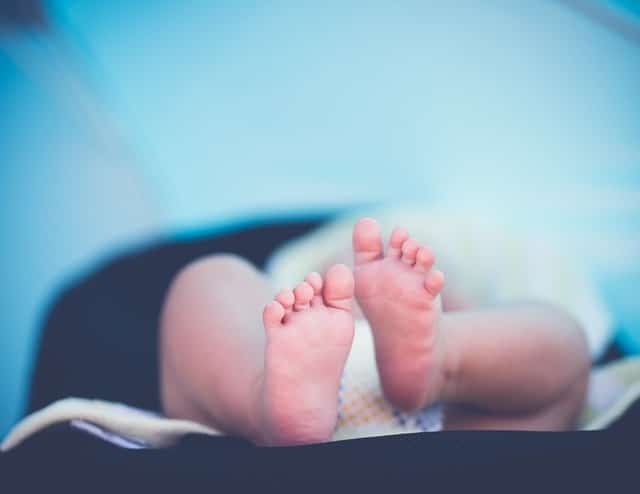Image credit to Geo.TV
Do Babies Have Kneecaps Having a newborn can be an incredible experience, and you’ll probably have a lot of humorous questions, some of which will sound completely absurd to everyone but you. However, you’re not the only parent who may be unsure if your child has kneecaps. In reality, many parents are just as confused as you are and will often Google the question, “Do babies have kneecaps?”
When you consider the situation, the query makes logic. Babies’ knees are pliable and not as firm as those of older children, much like the rest of their bodies. Many parents are left wondering what’s happening to those adorable little knees.
Do infants have kneecaps then? When do their knees start to stiffen up? Are injuries to a baby’s knees more common? In regards to baby knees, what more should parents be aware of? What the experts have to say is as follows.
Do Babies Have Kneecaps at Birth?
Our experts say that while babies do have kneecaps at birth, parents are frequently misinformed about this fact, and with good reason.
“There is a widespread misperception that infants are born without kneecaps,” explains Chris Airey, MD, medical director of Optimal and a former emergency room doctor. However, this is untrue. As a result of having fully cartilaginous kneecaps from birth, babies’ knees are known as “cartilage patellae,” or literally, cartilage kneecaps.”
Therefore, newborns do not lack kneecaps. Simply put, their kneecaps are constructed of a different material—one that is more suited to their developmental stage—than those of older kids and adults.
According to Dr. Airey, cartilage is a soft, flexible material that shields joints from friction. Naturally, babies would benefit from softer, more flexible kneecaps given the things they accomplish with their small bodies from infancy onward. “Less hard bone means an easier exit through the birth canal, and having soft, flexible knees is more conducive to all that crawling and toddling we do in our earliest years,” explains Dr. Airey.
When Do Babies’ Kneecaps Become Firmer?
But eventually, all of us get stronger kneecaps or patellae. Ossification, the process by which the patellae change from cartilage to bone, is often finished by the time a kid starts primary school.
According to Pierrette Mimi Poinsett, MD, a board-certified pediatrician and medical consultant at MomLovesBest, “the kneecaps transition to the bone between the ages of 2 and 6.” “The process is slow, starting in the center of the kneecaps and moving out to the edges.”
The knee joint still uses some cartilage in its functioning because it is designed to be flexible. Articular cartilage cushions the joint where the femur (leg bone) and patella (kneebone) meet. This keeps your knees safe from harm and facilitates seamless knee-to-leg movement.
Potential Issues With Kneecap Development
There’s no need to worry, even though your baby’s kneecaps may appear more sensitive and delicate than those of an older child. A baby’s kneecaps are really less vulnerable to traumas or health issues than those of an older child, according to Dr. Poinsett.
Recall that the flexible, squishy cartilage in your baby’s kneecaps is there for a purpose. It’s no wonder they can curl up into adorable tiny balls as babies and crawl around without getting wounded!
But there’s a chance for possible problems when the knees evolve from baby knees to more adult knees, says Dr. Airey. More specifically, your developing youngster may experience bipartite patella. “Since the kneecap forms in pieces that fuse over time, an issue that can occur is a bipartite patella, where the pieces haven’t fused completely and result in a sort of ‘split’ double kneecap,” according to Dr. Airey.
Physiotherapy can be used to manage this condition or it may sometimes resolve on its own. “The important thing is to watch for pain and swelling in your child’s knee area, as this could indicate a knee issue such as arthritis or an injury to the tendons or ligaments,” he states.
Also Read : 5 Common Breastfeeding Positions To Try
Common Knee Injuries in Children
Children are prone to injuries from time to time, especially those who participate in sports. Still, injuries to the kneecaps itself don’t generally occur.
According to Dr. Poinsett, “sprains or injuries to the ligaments surrounding the knee are more likely to cause knee pain in children.” “Kneecap injuries do happen, but they are uncommon.”
Children can still sustain knee injuries. The most frequent causes of knee injuries include direct impacts, abrupt twisting, and misuse of the knee and adjacent joints. Among the most typical knee injuries in children are the following:
- damage to the cartilage in the joints
- Tears in the anterior cruciate ligament
- Bursitis
- Displacements
- Breaks
- Meniscal cartilage tears
- The syndrome of patellofemoral stress
- Strains and sprains
- Tendon inflammation
When To Call the Doctor
Here are several indicators that your child might have a knee injury:
- reports of knee discomfort
- rigidity or incapacity to bend the knee or move the leg
- swelling near the knee or around it
You should see your doctor as soon as possible if you suspect your child may have had a knee injury or if they exhibit any of these symptoms. swelling near the knee or around it










